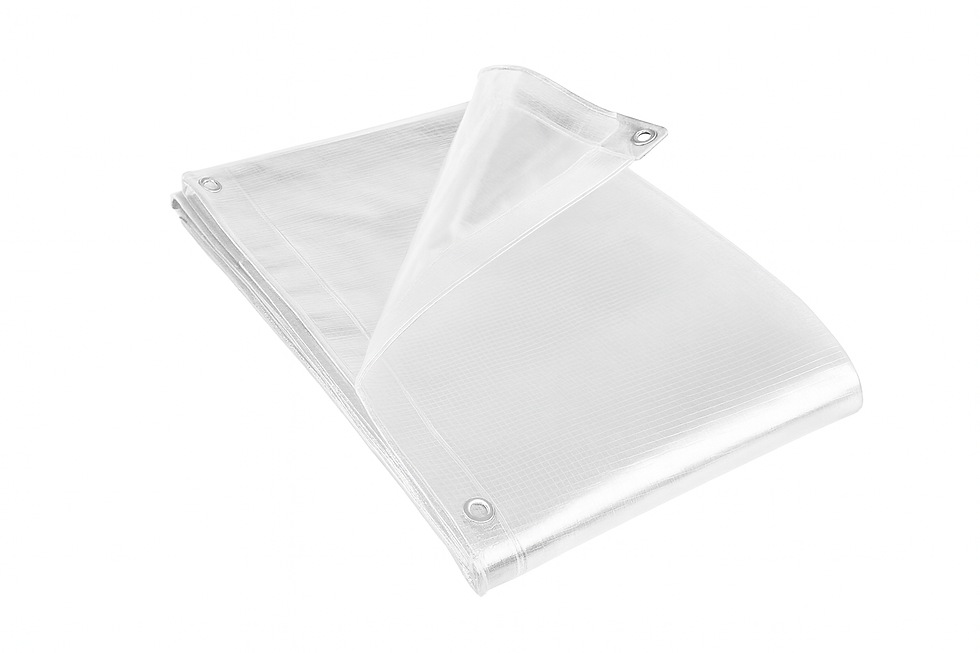The Science Behind Tarpaulin Materials
- UK Tarps
- Feb 1
- 3 min read
Tarpaulins, commonly called tarps, are flexible, resilient, and strong materials utilized for everything from keeping goods safe during transport to protecting people against the forces of nature. What makes Clear Tarpaulin so effective? The secret lies in the science behind their materials, which are specifically designed to achieve strength, flexibility, and resistance to environmental elements.
Composition of Tarpaulin Materials
Tarpaulins are usually made from synthetic or natural fabrics that are coated or laminated with plastic materials to increase their strength and resistance to weathering. The common materials used in the manufacture of tarpaulin include:
Polyethylene (PE): This is the most used material in tarps due to its lightweight and good resistance to water. PE tarpaulins are made from woven polyethylene fibers that are treated with a special coating of low-density polyethylene (LDPE) to provide flexibility and UV protection.
Polyvinyl Chloride (PVC): These tarps offer great strength, flexibility, and chemical resistance, as they are essentially a layer of PVC put onto the polyester fabric an ideal material used in applications of heavy-duty truck covers and industrial storage.
Canvas: Traditionally made from cotton or linen, canvas tarpaulins are breathable and durable. Mostly used in agricultural and outdoor applications, they are often treated with wax or oil to improve water resistance.
Polyester: Polyester tarpaulins are popular due to their high tensile strength and resistance to stretching and shrinking. Normally, they are coated with PVC or polyurethane for higher waterproofing properties and protection against ultraviolet rays.
Key Properties of Tarpaulin Materials
There are a few very important characteristics that define the effectiveness of a tarpaulin, which is engineered to meet certain specific requirements:
Water Resistance: Most tarpaulins are designed to be highly water-repellent, preventing moisture from penetrating and causing damage to the covered materials. PE and PVC tarps do well in this regard, thanks to their plastic coatings.
UV Resistance: The more a material is exposed to UV radiation, the more it deteriorates over time. Good tarps are UV-stabilized to prevent the sun's cracking, fading, and embrittlement.
Tensile Strength: The weight of a Tarpaulin, its heavy loads, and rough handling require it to have high tensile strength. It depends upon the weave pattern and thickness of fibers used in construction.
Flexibility: A good tarpaulin should have the characteristic to stay flexible under extreme temperatures. For instance, PVC tarps stay pliable under extremely cold weather conditions whereas, PE tarps can become brittle.
Tear Resistance: The tarpaulins should be strong enough to withstand tearing forces either from the shear of winds or from sharp-edged objects. In general, tear resistance can be enhanced by having reinforced edges with double-stitched seams.
Manufacturing of Tarpaulins
The production of tarpaulins is quite complicated, with each step designed precisely to enhance their performance and durability. First comes weaving: synthetic or natural fibers are interlaced in a fabric base that determines the strength and density of the tarp. Next, coating/lamination is applied: the woven fabric is further coated or laminated with plastic materials, such as PE or PVC, to make it impermeable and resistant to ultraviolet light.
Heat Sealing: Edges are sealed with heat or adhesives to prevent fraying and add strength.
Reinforcement: Other features, including grommets, reinforced corners, and double stitching, further enhance the structural integrity of the tarp.
Conclusion
Knowing what a White Tarpaulin is all about, and the science behind the material, really helps to match the right tarp with its particular use. From the lightweight PE tarp used for temporary coverage to heavy-duty PVC tarps used in industrial applications, the composition and properties of the material play a substantial role in how the tarp performs. With materials technology constantly improving, tarpaulins keep changing with growing durability, flexibility, and protection across many different industries.




Comments